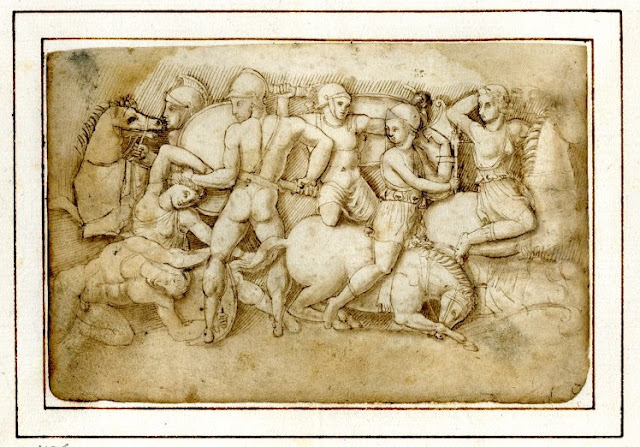 |
| Hellenistic Culture on Cyprus Battle of Greeks and Amazons ca. 350-300 BC marble sarcophagus relief Kunsthistorisches Museum, Vienna |
 |
| Anonymous Italian Artist after Polidoro da Caravaggio Battle of the Amazons 16th century drawing Art Institute of Chicago |
 |
| Enea Vico after Giulio Romano Battle of the Amazons 1543 engraving Art Institute of Chicago |
 |
| Léon Davent Battle of the Amazons 1547 etching Metropolitan Museum of Art, New York |
 |
| Biagio Pupini Study for Battle with Amazons before 1551 drawing Royal Collection, Great Britain |
 |
| Nicolas Beatrizet Battle of the Amazons 1559 engraving (left panel of pair to be joined) Metropolitan Museum of Art, New York |
 |
| Nicolas Beatrizet Battle of the Amazons 1559 engraving (right panel of pair to be joined) Metropolitan Museum of Art, New York |
 |
| Antonio Tempesta Battle of Greeks and Amazons 1600 etching Harvard Art Museums |
"Amazons exist in order to be fought, and ultimately defeated, by men, in an Amazonomachy ('Amazon-battle'). Already in the Iliad we hear of Bellerophon killing them in Lycia, their defeat at the river Sangarios, and a tomb of Myrrhine outside Troy. In Arctinus' Aethopis their queen, Penthesilea, 'daughter of Ares', arrives to help the Trojans, but Achilles kills her (and Thersites for alleging Achilles loved her). Heracles' ninth labour was to fetch the girdle of the Amazon queen, Hippolyte, resulting in another Amazonomachy. Theseus joined Heracles and as a result had to defeat an Amazon invasion of Attica, a story told in a late 6th-century BC Theseid."
"Amazons, appropriately for a group inverting normal Greek rules, live at the edge of the world. Their usual homeland is next to a river Thermodon in the city of Themiscyra in remote Pontic Asia Minor. Real Amazons would need men for procreation. Diodorus Siculus' Amazons at the Thermodon cripple their male children, but his second set, in Libya, have house-husbands to whom they return (like Greek males) after their period of military service. In Pseudo-Callisthenes' Alexander Romance they keep men across a river."
"Especially since J.J. Bachofen's Mutterrecht (1859) Amazons have been used as evidence for an actual matriarchy in prehistoric times. This has seemed an attractive counter to modern male prejudices, but mistakes the nature of myth. Woman warriors and hunters are quite frequent in myth and folk-tale, and inversely reflect the actual distribution of roles between the sexes. It may be that such inversion in Greece goes back to rituals of the initiation of maidens and youths, where the definition of gender roles is at issue."
– Oxford Classical Dictionary (third edition, 1996)
 |
| Johann Wilhelm Baur Battle of the Amazons 1636 etching Harvard Art Museums |
 |
| Gérard de Lairesse Amazon Battle ca. 1670 etching Rijksmuseum, Amsterdam |
 |
| Anonymous Artist working in Rome Sarcophagus Relief - Battle of Greeks and Amazons 17th century drawing British Museum |
 |
| Ignaz Elhafen Battle Scene with Amazons ca. 1680-85 cedar-wood relief Kunsthistorisches Museum, Vienna |
 |
| Lucas Vorsterman after Peter Paul Rubens Battle of the Amazons 1623 engraving (on six joined sheets) Harvard Art Museums |
 |
| Gaspard Duchange after Peter Paul Rubens Battle of the Amazons ca. 1778-82 porcelain plaque Rijksmuseum, Amsterdam |